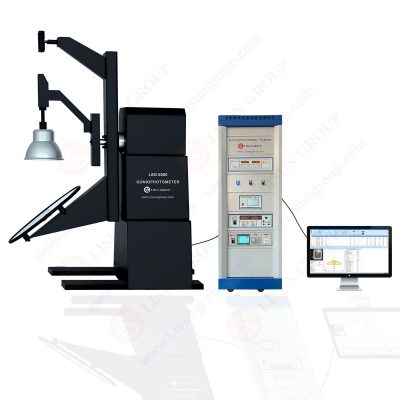

Abstract
This paper presents a comprehensive analysis of the performance characteristics of bulb lights, PAR lamps, and LED tubes through the LISUN LSG-6000 LM-79 Moving Detector Goniophotometer (Mirror Type C). Using the goniophotometer’s precise angular light distribution and photometric analysis capabilities, we evaluate these lighting products under LM-79 standards. Results highlight variations in luminous intensity, light distribution patterns, and color uniformity, providing insights into the strengths and limitations of each product type in specific applications.
Introduction
With the increasing need for energy-efficient and application-specific lighting solutions, the goniophotometer has become a pivotal instrument for evaluating lighting quality. The LISUN LSG-6000 LM-79 Moving Detector Goniophotometer (Mirror Type C) is particularly effective in providing accurate measurements of luminous flux, intensity, and distribution. This study uses the LSG-6000 to examine bulb lights, PAR lamps, and LED tubes, offering a detailed comparison in terms of their photometric properties.
LM-79 Moving Detector Goniophotometer (Mirror Type C)
Working Principle of the Goniophotometer
The LISUN LSG-6000 LM-79 Moving Detector Goniophotometer operates using a Type C mirror method, where the light source remains fixed, and the photodetector is positioned on an adjustable rotating arm. This design allows for precise measurement of luminous intensity distribution, while a mirror system reflects light onto the detector. By keeping the light source stationary, this model minimizes potential errors related to movement, which is particularly important when testing fixtures designed for various lighting applications.
Experimental Setup
Three types of lighting products were tested:
1. Bulb Light (Common residential bulb)
2. PAR Lamp (Common in retail and display lighting)
3. LED Tube (Used in commercial and industrial settings)
The LSG-6000 was configured to measure the luminous intensity and angular distribution, adhering to LM-79 standards. The test parameters included measuring the luminous intensity distribution over a 360° horizontal and 180° vertical range, color characteristics, and total luminous flux.
Results and Discussion
The data collected from the goniophotometer provided insights into the performance characteristics of each type of lighting product. The findings are summarized in the tables below.
Table 1: Luminous Intensity Distribution
Light Type
Luminous Intensity (Cd)
Horizontal Distribution (°)
Vertical Distribution (°)
Bulb Light
550
360
130
PAR Lamp
1250
60
70
LED Tube
900
120
180
The results in Table 1 indicate that the PAR lamp has a much higher luminous intensity compared to the bulb light and LED tube. This narrow, focused distribution is ideal for applications where targeted illumination is required, such as display lighting. In contrast, the LED tube has a wider distribution, which is beneficial for broader area lighting in commercial environments.
Table 2: Total Luminous Flux and Power Efficiency
Light Type
Luminous Flux (Lm)
Power Consumption (W)
Luminous Efficacy (Lm/W)
Bulb Light
800
10
80
PAR Lamp
1000
15
66.7
LED Tube
1500
18
83.3
The luminous efficacy, as shown in Table 2, is highest for the LED tube, indicating its superior efficiency. This efficiency advantage makes the LED tube suitable for extended use in industrial lighting applications, where energy costs and durability are critical.
Table 3: Color Uniformity and CCT (Correlated Color Temperature)
Light Type
CCT (K)
Color Uniformity (Δu′v′)
Bulb Light
3000
0.005
PAR Lamp
4000
0.008
LED Tube
5000
0.004
The color uniformity of the LED tube was observed to be superior, with a Δu′v′ value of 0.004, indicating minimal color variation across the light distribution area. This consistency is crucial for applications requiring high-quality, visually pleasing illumination, such as office and classroom settings.
Comparative Analysis
• Luminous Intensity and Distribution: PAR lamps are well-suited for directional lighting applications, providing high intensity over a narrow angle. Conversely, the bulb light and LED tube offer a broader distribution, making them more suitable for general lighting.
• Power Efficiency: The LED tube outperforms the other types in terms of luminous efficacy, aligning with industry trends favoring LEDs for energy efficiency. This makes LED tubes a preferable choice for long-term cost savings in large facilities.
• Color Temperature and Uniformity: The LED tube demonstrated higher CCT and more consistent color uniformity, enhancing its applicability in environments where visual comfort and consistency are prioritized.
Conclusion
Through comprehensive testing with the LISUN LSG-6000 LM-79 Moving Detector Goniophotometer, this study offers insights into the performance variations among bulb lights, PAR lamps, and LED tubes. The goniophotometer effectively reveals the suitability of each light type for specific applications:
• Bulb Light: Best for residential or general-purpose use due to its wide distribution and warmer color temperature.
• PAR Lamp: Optimal for focused lighting needs, such as display and retail applications.
• LED Tube: Ideal for large spaces requiring energy efficiency, high luminous flux, and color consistency.
This study emphasizes the value of goniophotometric testing for selecting lighting products aligned with specific operational needs, especially in commercial and industrial settings. https://www.lisungroup.com/news/technology-news/lisun-lsg-6000-lm-79-moving-detector-goniophotometer-mirror-type-c.html
.jpg)
Comments
Post a Comment